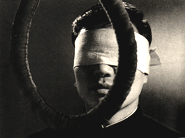A clinically presented series of stark white, unembellished placards illustrates the sobering statistical data for the overwhelming public sentiment against the abolition of the death penalty as an off-screen narrator (Nagisa Oshima) provides a snide, but impassioned rebuttal to popular opinion by presenting a objective documentary of the austere and impersonal milieu associated with the methodical process of carrying out a state execution through the specific example of the appointed hanging of a convicted rapist and murderer known only as ‘R’ (Do-yun Yu): an empty, minimalist sitting room that provides an illusive, parting glimpse of a semblance of home for the condemned prisoner as he makes his way into the execution room, an assembly of unnamed official guests waiting in a segregated viewing room to witness the macabre ceremony, a procedural rehearsal of the chamber’s fail-safe sequence as the prisoner is blindfold and fitted with a noose, the actuation of trap door, the median measured time of 18 minutes before the heart completely stops and a staff physician (Rokko Toura) is able to record the official time of death. However, the seemingly predictable execution script fails to correlate as expected, as the doctor continues to detect R’s breathing for several minutes beyond the expected point of expiration. The unexpected development shifts the film’s tone from observant polemic to wry, dark comedy as the guards – eager to disavow any culpability that may have led to the malfunction – are thrown into helpless confusion on how to proceed with the seemingly half-dead hanged man in order to complete their assigned task. Imploring the doctor to promptly resuscitate R as an ironic humane gesture so that he can regain consciousness before being put to death again (and therefore, have an awareness of his guilt), the guards soon realize that the trauma of the failed execution has resulted in the prisoner’s amnesia. Acting on the advice of the education officer (Fumio Watanabe), the officials begin to re-enact episodes from the trial transcripts before an impassive and oblivious R in order to trigger his memory, revealing a more insidious and pervasive cultural malaise that cannot be set right by the empty gestures of inequitable justice.
Inspired by the notorious, real-life execution of a convicted murderer named Ri Chin’u who had killed two Japanese schoolgirls in 1958 (and subsequently courted publicity for his crimes through the newspapers and the police), Death by Hanging is an ingeniously conceived, subversive, provocative, and elegantly modulated tragicomedy on intolerance, assimilation, and capital punishment. Using recurring imagery of circles – in particular, the hangman’s noose, the Japanese flag (a motif similarly used in Oshima’s earlier film, The Sun’s Burial), and the upended, spinning bicycle wheel – that is further reflected in the film’s circular narrative structure, Nagisa Oshima illustrates the overarching public complicity that has perpetuated the cycle of dehumanization, racism, and violence and continues to provide the ideological bulwark for the nation’s codified, postwar social policies that foster mono-ethnicity and conformity at the expense of inclusion and diversity. Through repeated episodes of role-playing and transference, Nagisa Oshima further creates an analogy for the collective subconscious that exposes the underlying hypocrisy of its entrenched (and obsolete) ideology: the physician’s suppressed history of committed wartime atrocities (that broadly reflects the nation’s prewar militarism, isolationism, and imperialism); the vulgar stereotypes of ethnic Koreans employed by the guards in an attempt to re-instill R’s ethnic identity (note the use of a non-diegetic German language soundtrack as R is brought to the beach that further reinforces the historical legacy of racial intolerance); the awkward (and absurdly comical) re-enactments of the victims’ abduction and violation that reveal the participants’ own sexual neuroses and ambiguity over shifting traditional gender roles in modern society. In the end, the provocative and intrinsically incendiary issue of death penalty merely provides an integrally self-enclosed structural framework (and microcosm) for the film’s more contemporarily relevant examination of marginalization, guilt, and social justice – a reluctant, but necessary expurgation rooted in the collective conscience of an unreconciled cultural identity.
© Acquarello 2005. All rights reserved.
